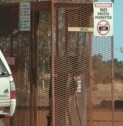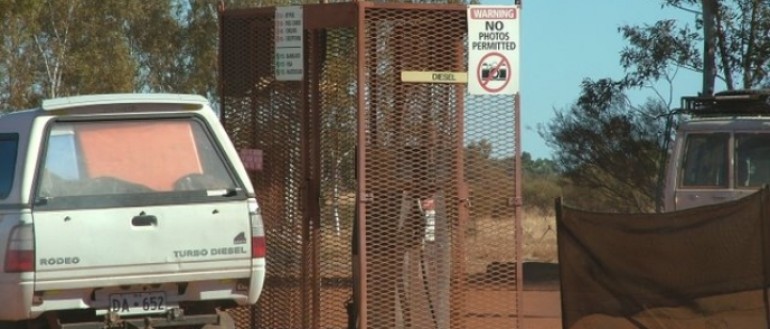Between 2000 and 2001, over 200 people were admitted to Northern Territory (NT) hospitals for psychological problems related to petrol sniffing.
Suicides were responsible for approximately 25 per cent of petrol sniffing related deaths in Central Australia during 1998–2003.
Petrol sniffing has been a major source of illness, death and social dysfunction in Indigenous communities over the past few decades. Sniffers start to experience feelings of euphoria, relaxation, numbness and weightlessness, but often end up with serious and irreversible brain and organ damage. The part of the brain that controls movement and balance is damaged and, eventually, users cannot walk or talk properly. Many sniffers end up in a wheelchair with severe, long term brain damage.
Sniffing also leads to behavioural and social problems and sniffers often get into trouble with the law for vandalism, violence, robbery and sexual assault. They find it difficult to stay at school and hold down jobs.
Poverty, boredom, unemployment, feelings of hopelessness and despair have contributed to the problem, aided by the low cost and ready availability of petrol. However, with the introduction of the federal Petrol Sniffing Prevention Program, including the roll out of Opal Fuel, and the NT Volatile Solvent Abuse Prevention Legislation, significant reductions in petrol sniffing in remote communities have been observed.
Our research focus:
- To research and educate to increase understanding and awareness of the harms of sniffing.
- To evaluate the impact of petrol sniffing policies.
Our research impact:
- We demonstrated that with abstinence from petrol sniffing, the brain could return to normal depending on the severity of impairment. Previously, there was no evidence suggesting that long-term brain damage associated with chronic petrol sniffing was recoverable.
- Our evaluations of the impact of Opal fuel have shown significant reductions in petrol sniffing and associated harms in regions where Opal fuel is available.
Key staff:
Collaborators:
- Northern Territory Government
- Department of Health and Ageing
- Council for Aboriginal Alcohol Program Services (CAAPS)
- Ilpurla
- Bowchung Pty Ltd
- Monitoring trends in the prevalence of petrol sniffing in selected Australian Aboriginal communities 2011-2014: Final Report.
- Cairney, S., O'Connor, N., Dingwall, K.M., Maruff, P., Shafiq-Antonacci, R., Currie, J., & Currie, B.J. (2013). A prospective study of neurocognitive changes 15 years after chronic inhalant abuse. Addiction, 108(6), 1107-1114.
- Dingwall, K.M., & Cairney, S. (2011). Recovery from central nervous system (CNS) changes following volatile solvent use (VSU). Substance Use and Misuse, 46(S1), 73-83.
- Dingwall, K.M., Lewis, M.S., Maruff, P., & Cairney, S. (2010). Assessing cognition following petrol sniffing for Indigenous Australians. Australian and New Zealand Journal of Psychiatry, 44(7), 631-639.
- Dingwall, K.M., Maruff, P., Clough, A.R., & Cairney, S. (2012). Factors associated with continued solvent use in Indigenous petrol sniffers following treatment. Drug and Alcohol Review, 31(1), 40-46.
- Dingwall, K.M., Maruff, P., Fredrickson, A., & Cairney, S. (2011). Cognitive recovery during and after treatment for volatile solvent abuse. Drug and Alcohol Dependence, 118(2-3), 180-185.
- Commonwealth Department of Health and Ageing. (2008). Executive summary of the "Evaluation of the Impact of Opal Fuel". Canberra, Australia: Commonwealth Department of Health and Ageing.
- d'Abbs, P., & MacLean, S. (2008). Volatile Substance Misuse: A Review of Interventions. National Drug Strategy Monograph Series No.65. Canberra: Australian Government Department of Health and Ageing.
- d'Abbs, P., & MacLean, S. (2011). Petrol Sniffing Interventions Among Australian Indigenous Communities Through Product Substitution: From Skunk Juice to Opal. Substance Use & Misuse, 46(S1), 99-106.
- MacLean, S., & d'Abbs, P. (2002). Petrol sniffing in Aboriginal communities: a review of interventions. Drug and Alcohol Review, 21(1), 65-72.
- MacLean, S., & d'Abbs, P. (2006). Will modifying inhalants reduce volatile substance misuse? A review. Drugs: Education, Prevention and Policy, 13(5), 423-439.
- MacLean, S., & d'Abbs, P. (2011). Five challenges for volatile substance misuse policy and intervention in Australia. Drug and Alcohol Review, 30(2), 223-227.
Click here to view more petrol sniffing publications in PubMed.
-
.jpg&w=123&h=126)
Health survey of male Aboriginal and Torres Strait Islander in the NT
The Alcohol, Other Drugs, and Gambling (AODG) Unit at Menzies School of Health Research is leading a research project relating to Health Literacy Among Young Aboriginal and Torres Strait Islander Males in the NT.
-
Sustained reduction in petrol sniffing after low aromatic fuel rollout
Researchers from The University of Queensland and Menzies School of Health Research have evaluated prevalence and patterns of inhaling petrol since the introduction of low aromatic fuel (LAF).
-

Petrol sniffing stunts the growth of children
“Petrol sniffing makes you shorter, and there’s no way to catch up even after you stop sniffing” says Professor Andrew Lawrence at the Florey Institute of Neuroscience and Mental Health
-

Research: petrol sniffing on decline
Petrol sniffing rates in Indigenous communities have declined since the introduction of low aromatic unleaded fuel (LAF), a study by Menzies School of Health Research has revealed.
-

Sharp decreases in petrol sniffing rates
NEW research has found that petrol sniffing in Indigenous communities across the Northern Territory has declined by 30 per cent since 2011.
-

Petrol sniffing on the decline in Indigenous communities
Petrol sniffing rates in Indigenous communities have declined since the introduction of low aromatic unleaded fuel (LAF), a study by Menzies School of Health Research (Menzies) has found. The results of this study were released today by Senator the Hon Nigel Scullion Minister for Indigenous Affairs.
-
Barkly fuel ban to stem sniffing
REGULAR unleaded petrol could be outlawed in Tennant Creek as early as January, in a bid to completely stamp out petrol sniffing in the Barkly.
-

Queensland mayor slams Commonwealth move to ban regular unleaded fuel on Palm Island
A north Queensland mayor has slammed the Federal Government's decision to ban the sale of regular unleaded petrol in his community.
-

Report reveals decline in petrol sniffing
The report has shown that in 15 Aboriginal communities where available data enables comparisons to be made, there was more than an 80 per cent decline in the number petrol sniffers from 2005-07 to 2011-12.
-

Menzies research reveals marked decline in petrol sniffing
A Menzies report has revealed a significant decline in the prevalence of petrol sniffing in a number of Aboriginal communities across Australia.
-

Research reveals complete recovery of brain function for chronic petrol sniffers
The final results of a groundbreaking, long-term study prove that brain damage can be completely reversed when people stop sniffing petrol but the recovery can take years.


